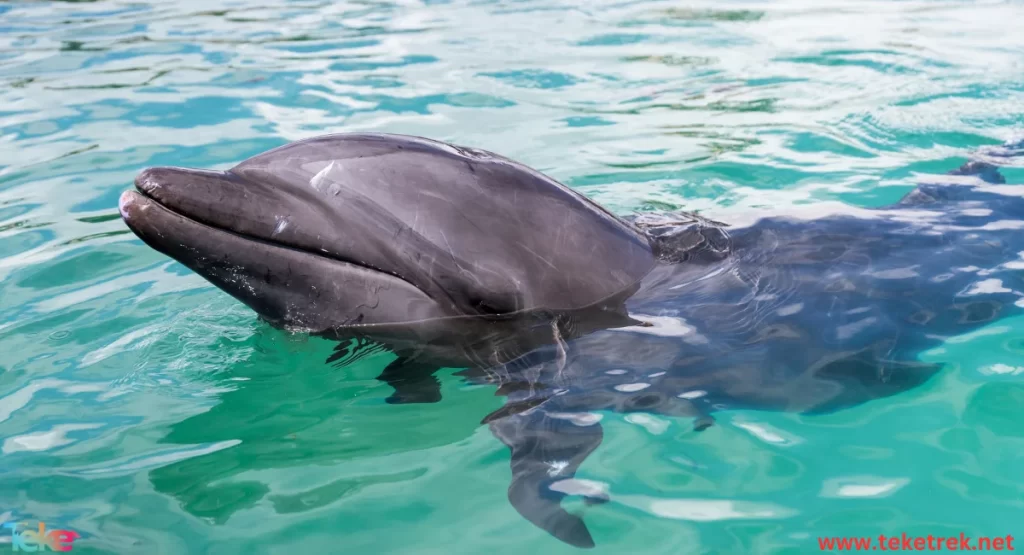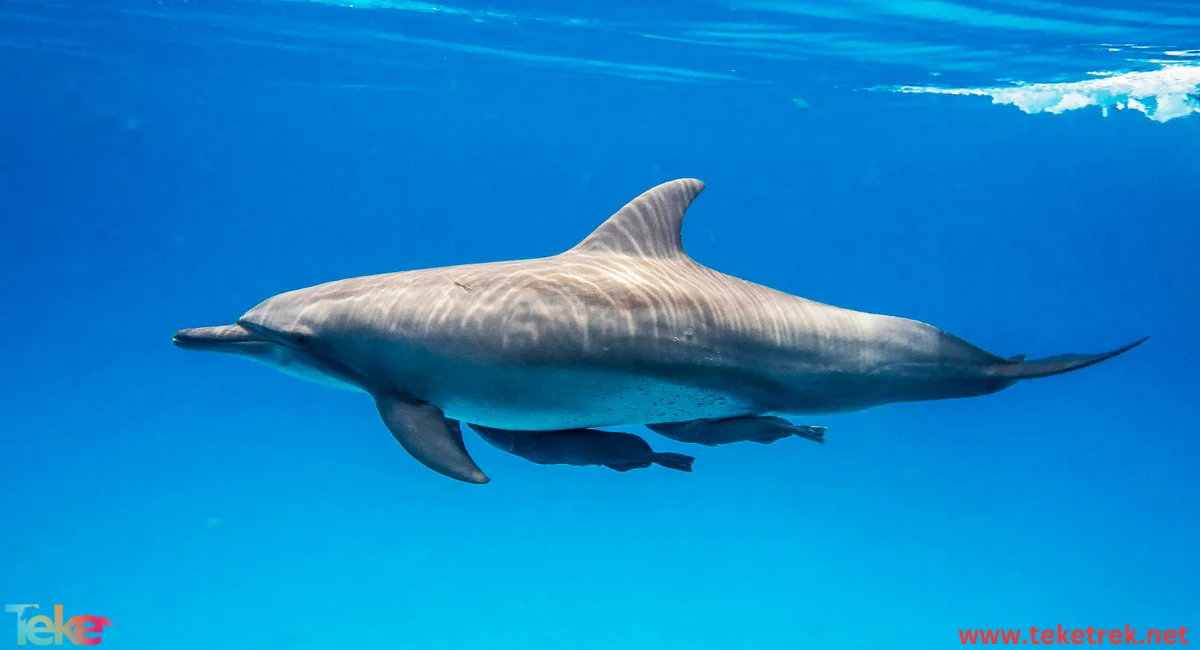The Bottlenose dolphin one of the most famous dolphin species, is one of the most intriguing and captivating marine creatures. It is considered one of the most intelligent and interactive mammals in the world of the seas. This animal is distinguished by its beauty and intelligence, making it the focus of attention for both researchers and the general public alike.

Known for its striking social behaviors and high intelligence, it has fascinated humans for a long time. Its distinctive appearance on the water’s surface and its remarkable communication abilities have captured the interest of researchers and seafarers throughout the ages.
Scientific Name: Tursiops truncates, in this article from Teketrek we will talk more about it.
The most important specifications of the bottlenose dolphin
- It is characterized by its strong and sleek body, known for its gray, blue, and white colors. The back is often dark gray, while the sides and belly are light gray, but it can also have bluish-gray, gray-brown, or even almost black colors.
- It measures between 2 to 4 meters in length and weighs between 150 to 650 kilograms.
- Moreover, the dolphin is characterized by its prominent and pointed head, featuring a distinctive large nose that resembles a bottle, a unique feature for this dolphin species. This prominent feature sets it apart from other dolphin species that differ in nose shape.
- It has a dorsal fin that extends along its back, aiding in controlling its movements while swimming. Additionally, it possesses a fluke or “wave fin” on the lower part of its body, which also helps in swimming and steering.
- Considered one of the most intelligent marine mammals, it possesses exceptional abilities to understand commands and communicate with humans.
- Lives in social groups called pods, and these groups can consist of tens to hundreds of dolphins.
- Utilized in various scientific research and marine shows as a means of raising awareness and educating about marine environments and conservation.
- The dolphin is considered an agile and fast marine animal, capable of swimming at speeds ranging from 5 to 11 kilometers per hour (1.4 to 3.1 meters per second). It can reach even higher speeds of 29 to 35 kilometers per hour (8.1 to 9.7 meters per second) when jumping. However, these high speeds can be maintained for a short period.
- Possesses sensitive senses that help in finding food and communicating in its aquatic environment.
Dolphin age
- Its lifespan depends on multiple factors, but bottlenose dolphins can live up to 40 years and potentially longer in favorable conditions.
The intelligence of the bottlenose dolphin
- They exhibit high levels of thinking and intelligence, possessing cognitive ratios comparable to those in humans and other cetaceans. This is believed to contribute to their high intelligence and emotional intelligence.
- Their interaction with humans showcases the extent of their intelligence. They have been trained by navies to detect sea mines or locate and identify enemy divers.
- They also assist local fishermen in fishing by herding fish towards their nets. However, some interactions with humans can be harmful to dolphins.
- Some are hunted for food and accidentally killed during tuna fishing.
- Bottlenose dolphins possess the third-highest level of brain enlargement among terrestrial mammals, which contributes to their high intelligence.
Bottlenose dolphin reproduction
- They are mammals animals, have a complex social system and live in groups known as “pods” or “families.”
- The sexual maturity of dolphins ranges from 5 to 14 years, with males reaching sexual maturity relatively later compared to females.
- Pregnancy typically lasts between 10 to 12 months, and when females give birth, it’s usually to a single calf.
- Mothers exhibit great care for their young, understanding and being attentive to their needs. They provide care and protection during the nursing, swimming training, and hunting instruction periods.
- The nursing period can last from 18 months to 8 years, and the calves usually stay with their mothers for two to three years before becoming fully independent.
Habitat and presence of the bottlenose dolphin
- They live in warm and temperate marine waters around the world.
- They inhabit large oceans and coastal waters.
Bottlenose dolphin behavior and personality
- Renowned in the animal kingdom, dolphins are known for their high intelligence and ability to interact with humans and other creatures.
- They perform maneuvers in the water, communicate with their distinctive vocalizations, and respond to training.
Bottlenose dolphin food
- Their diet includes a variety of fish, shrimp, squid, and mollusks, with a preference for the soft parts.
- Dolphins exhibit cooperative and communal hunting strategies, facilitating their food acquisition. For instance, they participate in group hunting, collaborating to herd fish toward the shore and capitalize on easily accessible catches.
- Echolocation is a vital technique that assists dolphins in locating food. It involves emitting high-frequency sound pulses that collide with objects in the water and return as echoes.
- Dolphins use this echolocation to identify surrounding objects, enabling them to discern the shape, size, speed, and precise location of the targeted creature.
- Dolphins receive the echo through small ear openings, but they transmit a significant portion of the sound waves to the inner ear through the lower jaw. As dolphins approach the target, the echo density increases, and the time interval between clicks decreases.
- This intelligent system allows dolphins to explore and understand their environment accurately and efficiently.
How do dolphins breathe?
- Has a single blowhole located on the top of its head, opening and closing by a muscular membrane. It breathes voluntarily and needs to surface to breathe.
- It can store a large amount of oxygen, allowing it to stay submerged for approximately 20 minutes between each breathing cycle.
Bottlenose dolphin species
It comprises three main species:
1. Common Bottlenose Dolphin (Tursiops truncatus):
This is the most common species found in various warm and temperate oceans.
2. Indo-Pacific Bottlenose Dolphin (Tursiops aduncus):
This species inhabits warm and temperate regions in the Indian and Pacific Oceans.
3. Burrunan Bottlenose Dolphin (Tursiops erebennus):
Observers have noted the presence of this rare species in waters near New Zealand.
Additionally, there are some subspecies and potential variations, such as the Burrunan Dolphin, which some consider to be an independent or subspecies of the Indo-Pacific Bottlenose Dolphin.


Bottlenose dolphins communicate with each other
- Dolphins communicate through pulsating sounds, whistles, and body language, including leaping out of the water, jaw popping, tail slapping on the water’s surface, and head-butting.
- Sounds and gestures serve as a means to coordinate with the rest of the dolphin pod, alerting other dolphins to danger or nearby food. They don’t have vocal cords; instead, they produce sounds using an air sac near the blowhole. Each dolphin has a unique signature whistle known as a “signature whistle.
FAQ
- What is the difference between a bottlenose dolphin and a common dolphin?
The bottlenose dolphin is slightly larger than a dolphin and weighs a few hundred kilograms. The dorsal fin of the bottlenose dolphin is false-gray in color, while it is triangular in shape with a pale center in the pallid dolphin.
- Why are they called bottlenose dolphins?
The bottlenose dolphin is called because it has a short snout.
- Are bottlenose dolphins friendly to humans?
Dolphins are generally known to be friendly, but this does not negate caution when dealing with them.
- Is a dolphin a whale?
Yes, the dolphin is a whale and it is the largest cetacean species.
Finally
Experts generally do not consider the Bottlenose Dolphin endangered; however, environmental changes pose threats to some populations in specific regions. For instance, dolphins in areas like the Moray Firth in Scotland and the Dusky Sound in New Zealand are facing threats due to pollution, food resource depletion, and an increase in the flow of warm freshwater into their surrounding areas. Nevertheless, environmental conservation laws protect dolphins and other marine mammals in most American waters.






